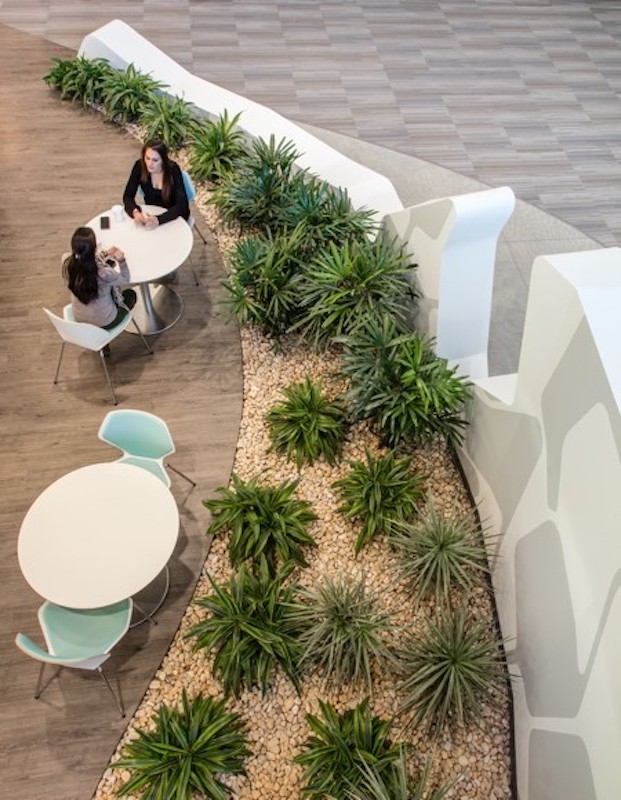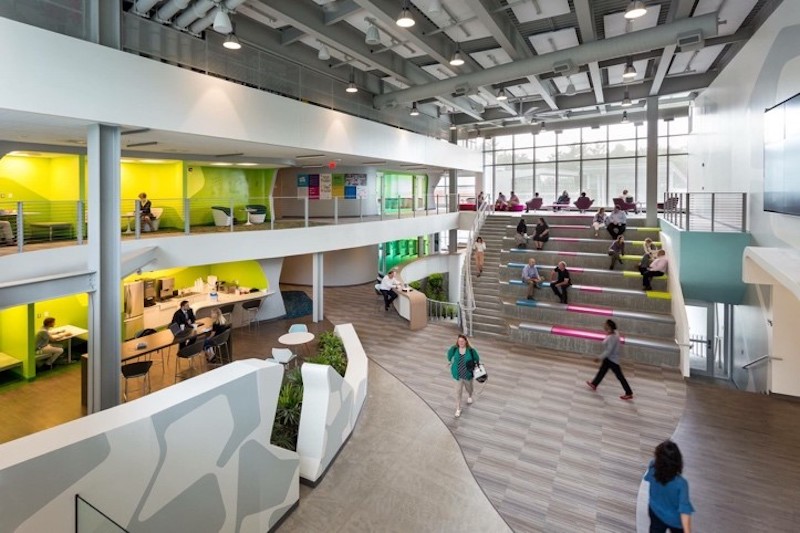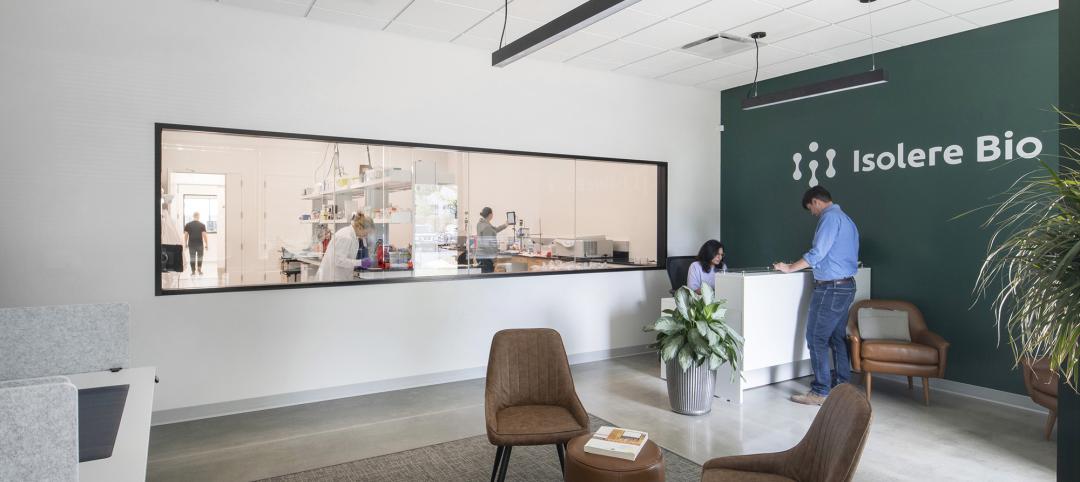An R&D building on the Billerica, Mass., campus of EMD Serono—a biopharmaceutical business of Merck KGaA, Darmstadt, Germany that focuses on specialty care—became the first in the United States to receive Gold-level certification for New and Existing Buildings from the International WELL Building Institute.
The Sagamore Building, as it is known, is part of a three-building, 275,000-sf campus with more than 500 employees who work to accelerate R&D innovation in oncology, immune-oncology, and immunology. The campus is one of four global R&D hubs for the company.The Sagamore Building, which was completed last year, has also earned LEED Platinum certification from the U.S. Green Building Council.
To achieve WELL certification, EMD Serono started with a two-day design charette that included architects, engineers, designers, and facilities managers who brainstormed, built models, and challenged notions of space. (The Building Team included Boston-based architect Ellenzwieg.)
To meet WELL’s building standard, the project—which included a new addition and a retrofit of an existing building—installed WELL-compliant lighting fixtures, and MERV 15 high efficiency air filters under ASHRAE 52.2/MERV. EMD Serono also changed to compliant cleaning chemicals and protocols, and increased its preventive maintenance schedules to quarterly, with photographic documentation of service.

EMD Serono's Sagamore Building offers its employees a variety of healthier spaces in which to work and collaborative. Image: EMD Serono
Employees now have a variety of work environments to choose from, including open spaces, huddle rooms, and designated technology-free quiet zones. WELL also requires stairs between floors to encourage exercise and occupant movement. The design of the Sagamore building’s bleacher seating and auditorium was conceived during the design phase. The seating’s construction involved rebar and build forms that were supported with special staging for several concrete pours.
The Sagamore Building underwent testing and a final evaluation by Green Business Certification Inc. (GBCI), WELL’s third-party certification entity, which corroborated that the built environment was designed to improve occupants’ nutrition, fitness, mood, sleep patterns and performance.
Anthony Meenaghan, EMD Serono’s Senior Director, Facilities Management and Engineering, Environmental Health & Safety, says the WELL certification highlights his company’s collaborative and knowledge-sharing culture. “Offering employees an environment where they can do their best work plays an important role in bringing meaningful solutions to people with difficult-to-treat diseases.”
Related Stories
Laboratories | Apr 22, 2024
Why lab designers should aim to ‘speak the language’ of scientists
Learning more about the scientific work being done in the lab gives designers of those spaces an edge, according to Adrian Walters, AIA, LEED AP BD+C, Principal and Director of SMMA's Science & Technology team.
Laboratories | Apr 15, 2024
HGA unveils plans to transform an abandoned rock quarry into a new research and innovation campus
In the coastal town of Manchester-by-the-Sea, Mass., an abandoned rock quarry will be transformed into a new research and innovation campus designed by HGA. The campus will reuse and upcycle the granite left onsite. The project for Cell Signaling Technology (CST), a life sciences technology company, will turn an environmentally depleted site into a net-zero laboratory campus, with building electrification and onsite renewables.
Laboratories | Apr 12, 2024
Life science construction completions will peak this year, then drop off substantially
There will be a record amount of construction completions in the U.S. life science market in 2024, followed by a dramatic drop in 2025, according to CBRE. In 2024, 21.3 million sf of life science space will be completed in the 13 largest U.S. markets. That’s up from 13.9 million sf last year and 5.6 million sf in 2022.
Sustainability | Mar 21, 2024
World’s first TRUE-certified building project completed in California
GENESIS Marina, an expansive laboratory and office campus in Brisbane, Calif., is the world’s first Total Resource Use and Efficiency (TRUE)-certified construction endeavor. The certification recognizes projects that achieve outstanding levels of resource efficiency through waste reduction, reuse, and recycling practices.
Adaptive Reuse | Mar 7, 2024
3 key considerations when converting a warehouse to a laboratory
Does your warehouse facility fit the profile for a successful laboratory conversion that can demand higher rents and lower vacancy rates? Here are three important considerations to factor before proceeding.
University Buildings | Feb 21, 2024
University design to help meet the demand for health professionals
Virginia Commonwealth University is a Page client, and the Dean of the College of Health Professions took time to talk about a pressing healthcare industry need that schools—and architects—can help address.
Urban Planning | Feb 5, 2024
Lessons learned from 70 years of building cities
As Sasaki looks back on 70 years of practice, we’re also looking to the future of cities. While we can’t predict what will be, we do know the needs of cities are as diverse as their scale, climate, economy, governance, and culture.
Laboratories | Feb 5, 2024
DOE selects design-build team for laboratory focused on clean energy innovation
JE Dunn Construction and SmithGroup will construct the 127,000-sf Energy Materials and Processing at Scale (EMAPS) clean energy laboratory in Colorado to create a direct path from lab-scale innovations to pilot-scale production.
Laboratories | Jan 25, 2024
Tactical issues for renovating university research buildings
Matthew Plecity, AIA, ASLA, Principal, GBBN, highlights the connection between the built environment and laboratory research, and weighs the benefits of renovation vs. new construction.
Laboratories | Jan 22, 2024
Speculative vs purpose-built labs: Pros and cons
Hanbury's George L. Kemper, AIA and R. David Cole, AIA share the unique advantages and challenges of both spec. and purpose-build labs.

















